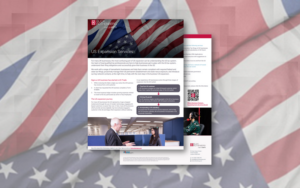Additional UK Guidance for Transfer Pricing Compliance
This additional guidance should be a wake-up call to all international businesses with a presence in the UK where compliance with the UK’s TP rules is required
9 April 2025 | Author: Susan Vincent
Additional UK Guidance for Transfer Pricing Compliance
Transfer pricing (’TP’) refers to the requirement to price transfers of goods, services, intangible assets or financing between related parties on the same terms as if the counterparties were unconnected (i.e., at ’arm’s length’). This requirement is applicable under both tax treaties and domestic legislation and is the long-established international norm designed to best ensure profits arise and are taxed in the right jurisdictions.
Whilst the OECD Transfer Pricing Guidelines for Multinational Enterprises and Tax Administrations (the ’OECD Guidelines’) form the interpretative basis for UK TP law, historically there has been limited additional guidance from HMRC regarding the content of transfer pricing documentation required to demonstrate the arm’s length position of UK entities.
In addition, HMRC have been critical over recent years of much of the UK TP documentation they have seen during their tax return checks and audits, highlighting insufficient fact-gathering and weak economic analyses. In response, HMRC have issued over 100 pages of additional guidance for UK TP compliance (GfC7) setting out their take on best practice. This was released in September 2024 and presented on a webinar in March 2025.
This additional guidance should be a wake-up call to all international businesses with a presence in the UK where compliance with the UK’s TP rules is required. What may previously have sufficed, may no longer be acceptable. The new guidance is peppered with references to the UK’s penalty regime, which signals a more robust focus on penalties where there have been failures to apply HMRC’s new best practices.
The comprehensive guidance is split into three main sections:
- Managing compliance risk for UK businesses
- Common compliance risks
- Indicators of transfer pricing policy design risk
Some key elements from these sections are set out below.
Part 1 – Managing compliance risk for UK businesses
To effectively manage compliance risk, the UK risk lead (e.g., in-house tax or finance team member, accounting officers) must ensure proper compliance planning and have oversight of TP processes. This includes clearly identifying the transactions that fall under UK TP regulations and defining the scope of work undertaken in-house or by an external advisor.
The UK risk lead is required to have a thorough understanding of TP policies applicable to the UK entity (even if the group is headquartered overseas) and ensure the functional and economic analyses are consistent with the way the UK business operates commercially. This includes monitoring developments in the business which may have an impact on the TP policies (e.g., change in supply chain, new intercompany transactions, acquisitions and disposals). The risk lead must also monitor the correct implementation of TP policies and discuss variances with specialists if required.
Best practices include that UK risk leads should share key relevant information and evidence with specialists if work is outsourced, regularly conduct risk assessments to identify potential issues, and ensure consistent, clear, and up-to-date documentation to substantiate that transactions between related entities adhere to the arm’s length principle.
Part 2 – Common compliance risk
HMRC often encounter TP documentation that is overly high-level, lacks evidentiary support, and presents a one-sided functional analysis. While compliance budgets can limit scope, failure to conduct thorough fact-finding can lead to costly consequences: increased compliance costs because of enquiries, TP adjustments, interest, and penalties.
Common issues with functional analyses highlighted by HMRC include:
- Performing analyses after finalising statutory accounts
- Limited or centralised reports lacking UK input
- Rolling forward functional analyses and benchmarking studies without an annual review
- Insufficient analysis of risks, intangible assets, and employee functions
- Over reliance on contractual terms without demonstrating how risks are managed in practice
Best practices include performing detailed functional interviews, involving personnel across functions and jurisdictions, and avoiding ’roll-forward’ of prior year analyses without appropriate updates. Documentation should draw from financial reports, public information, and internal records, ensuring alignment with commercial reality. Documentation must also clearly explain how staff functions, risk control, and intangibles are managed and exploited within the UK.
From a comparability perspective, HMRC advise thoroughly testing for internal comparables first. If an external benchmarking study is required, it is important to make sure that the search parameters for external comparables align with the activities and comparability factors arising from the functional analysis specific to the UK entity and adjustments are applied where appropriate.
Finally, it is important to be able to reconcile the UK entity’s results to the TP policies applied. Supporting documents should have an audit trail summarising how the costs and revenues used for calculations tie to the statutory accounts, align with the TP model, and account for varying accounting practices and currencies within a group where relevant.
Part 3 – Indicators of transfer pricing design risk
HMRC have identified several policy design elements as indicators of potential TP risk, particularly where they diverge from economic reality.
These include:
Heavy reliance on contractual allocation of risk or legal ownership of assets.
Centralised Intellectual Property ownership in locations outside where key value driving activities and management of economically significant risks are being performed.
Above market intra-group services (i.e., key functions within the UK that perform a wider role than the rest of the UK business).
Limited risk target margin models or simplistic cost-plus/service-based remuneration without adequate support.
Bundling transactions in a single fee approach (e.g., franchise fee structures or other arrangements) without sufficient support or where UK functions appear undervalued.
The guidance in this area is extensive, providing numerous examples of high-risk indicators increasing risk of enquiry and best practice approaches to reduce risk.
Supporting Documentation & Record Keeping
As noted above, the compliance notes signal a change in the level and depth of what HMRC expect to be kept and prepared for TP compliance purposes, although judgment is still required to be exercised to ensure that what is kept remains proportionate to risks and materiality of the UK business.
In addition to the TP documentation that includes functional and economic analyses adhering to the best practices now set out, HMRC expect businesses to prepare and retain other relevant supporting documents that evidence functions, roles and responsibilities such as meeting notes and Board/Committee minutes where appropriate, and that contracts are in place covering the intragroup transactions and TP policies that align with the business. Annual functional and risk analysis of key transactions should be conducted to identify any changes and ensure ongoing compliance.
Further Indicators of Potential HMRC Scrutiny
It is worth noting that the yield from HMRC for TP adjustments amounted to £1.8bn in 2023/24, up 9.2% on the previous year. TP continues to be a key focus for HMRC in managing tax compliance.
HMRC will be undertaking a risk review before launching a TP enquiry. Indicators that may trigger HMRC scrutiny include:
- Losses, fluctuating or consistently low or zero-profit margins
- Material share-based compensation
- Complex group structures and ambiguous value attribution
- Transactions involving low-tax jurisdictions
These red flags can feature in HMRC’s risk assessment leading to potential investigations on compliance with UK TP law. As noted above, the guidance includes numerous references to penalties, indicating that HMRC are taking a robust approach to monitoring TP compliance and will be more routinely seeking penalties.
Key Takeaways
Transfer pricing policies should reflect the commercial operations and business activities.
Transfer pricing documentation should be comprehensive and cover all areas of the UK business in sufficient detail.
Functional analyses must identify how risks are controlled and managed rather than solely relying on contractual and legal agreements, and supporting evidence is to be retained. The UK risk lead must review and sign these off, ensuring accuracy and completeness.
Economic analyses must be robust, comprehensive, and backed by appropriate comparables.
Regular monitoring is essential to identify risks early and to ensure compliance.
Tax geared penalties are likely to be pursued by HMRC where best practices are not followed, and profit adjustments are made during tax audits.
Would you like to know more?
If you would like to discuss any of the above and how it impacts you, please speak to your usual Blick Rothenberg contact, or Susan Vincent using the form below.
Contact Susan

You may also be interested in

Contractors and subcontractors in the UK construction sector must understand the Construction Industry Scheme

Vodcast – Steve Rigby











